 Business
Business
Maintaining Optimal Soil Balancing Using Advanced pH Balance
- by Rahuldoshi
In the intricate science of crop cultivation, soil pH stands as a foundational variable that directly governs nutrient bioavailability, microbial activity, and overall crop productivity. Yet, despite its significance, soil pH management is often underestimated or poorly executed by cultivators. Whether one is managing a high-value polyhouse crop or open-field grain production, understanding and controlling soil pH is imperative to unlock the soil’s full potential.
Today, with cutting-edge agri products and integrative platforms like the Agribegri app, progressive khedut (farmers) are empowered with unprecedented access to data-driven insights and precision-input tools. This has elevated traditional farming into a more calculated practice—one where every variable, including pH, can be fine-tuned for optimal outcomes.
Advanced pH balancers are at the forefront of this transformation. Unlike conventional liming agents or acidifiers, modern pH balancers are formulated with bio-compatible compounds, stabilizers, and sometimes even microbial consortia to create a holistic response to soil chemistry irregularities. These formulations not only correct pH but also support long-term soil health, a critical factor in sustainable crop management strategies.
The Science Behind Soil pH and Its Agricultural Impact
Soil pH is a logarithmic scale measuring the hydrogen ion concentration in the soil, with 7 as neutral. Slight deviations, even by 0.5 units, can radically alter the solubility of key nutrients such as phosphorus, iron, manganese, and zinc. In acidic soils (pH below 6), metals like aluminum and manganese may become toxic, while alkaline soils (pH above 7.5) often lock essential micronutrients, rendering them insoluble to plants.
Research indicates that over 60% of Indian agricultural soils fall outside the optimal pH range for nutrient uptake. This has a direct correlation with reduced nutrient-use efficiency and poor yield response, even when high-quality fertilizers are applied.
Moreover, soil pH influences:
- Microbial population dynamics, affecting nitrogen fixation and organic matter breakdown
- The efficacy of herbicides and other crop inputs
- Root system architecture and rhizosphere activity
Such dependencies make it evident that pH isn’t just another statistic—it’s a pivotal factor in agronomic decision-making.
Key Challenges Farmers Face in Achieving pH Equilibrium
Indian agriculture, characterized by its diversity of soil types and regional climates, presents unique challenges in maintaining a balanced pH. For instance, red soils in the south are naturally acidic, while alluvial soils in northern plains lean toward alkalinity due to excessive irrigation and poor drainage.
Common challenges include:
- Infrequent soil diagnostics: Many khedut still rely on visual crop symptoms rather than proactive soil testing.
- Over-application of amendments: Improper use of lime, gypsum, or sulfur leads to secondary imbalances and depletion of organic matter.
- Lack of crop-specific inputs: Using general-purpose soil correctives without consideration for crop sensitivity or root zone pH can do more harm than good.
These challenges necessitate a shift toward personalized soil care, supported by precision agri tools and adaptive formulations.
Advanced pH Balancer Products Reshaping Modern Farming
To meet the demands of diverse cropping systems and soil types, a range of scientifically-formulated pH balancers have entered the market. These solutions are designed not only for reactivity but also for consistency, offering long-term buffering capacity and compatibility with integrated nutrient management systems.
1. AgrowDose pH Balancer
Composition: A synergistic blend of weak organic acids, chelating agents, and carbon complexes.
Target Use: Neutralizing alkaline soils commonly found in canal-irrigated regions.
Application Method: Dilute in irrigation water (drip or flood) at a dose of 2-4 ml/L.
Best Time to Use: During initial land preparation or before critical crop stages such as flowering.
Advantages:
- Unlocks phosphorus bound in calcareous soils
- Maintains microbial viability due to moderate action
Limitation: Requires sequential application in soils with persistent high bicarbonates.
2. Soilrite Acidifier
Formulation: Chelated sulfuric acid precursors combined with organic fulvic enhancers.
Ideal For: Fruit orchards, vineyards, and perennial crops susceptible to root zone alkalinity.
Application: Injected via fertigation to ensure even distribution.
Strengths:
- Reduces salt accumulation
- Improves cation exchange capacity (CEC) in subsoils
Caution: Not suited for high-rainfall zones where leaching may reduce efficacy.
3. Greenzyme Bio pH Regulator
Source: Derived from microbial fermentation of sugarcane molasses and neem extracts.
Application Niche: Organic-certified farms and regenerative agriculture systems.
Best Time to Apply: Post-harvest and during fallow periods to enhance soil biological activity.
Benefits:
- Increases humus content and soil porosity
- Reestablishes native microbial balance
Trade-off: Gradual correction—results appear over 3 to 6 weeks.
4. pHixit Max
Chemical Base: Polycarboxylic acids with silicate stabilizers.
Designed For: Controlled environment agriculture (greenhouses, vertical farms).
Application Mode: Direct mixing with nutrient solution reservoirs or mainline irrigation.
Key Features:
- Rapid neutralization of bicarbonates in hard water
- Compatible with micronutrient foliar sprays
Drawback: May require water quality assessment prior to application.
“Healthy soil is not a given—it’s a result of continuous stewardship, guided by science and sustained by intention.”
Digital Tools and Their Role in Sustainable Soil Management
Digital agriculture is not a trend—it’s a necessity. By integrating pH monitoring with agro app platforms, farmers can transform reactive soil care into predictive management. Apps can synchronize data from soil sensors, satellite imagery, and local climate forecasts to suggest tailored input schedules.
For instance, AI-driven platforms can:
- Predict soil pH fluctuations based on rainfall and irrigation patterns
- Send alerts for corrective action windows during crop-sensitive growth stages
- Recommend compatible agri products based on historical crop data
Farms utilizing these tools have reported a 30-40% increase in resource use efficiency and enhanced soil organic matter retention across growing seasons.
Actionable Guidelines for Khedut: Building a pH-Smart Soil Plan
To sustain soil health while maximizing returns, here are best practices tailored for today’s khedut:
- Integrate soil pH testing into every seasonal land preparation cycle.
- Apply site-specific pH balancers in accordance with crop requirements and water quality.
- Reassess soil pH after irrigation shifts (e.g., from canal to borewell).
- Avoid over-liming or acidifying—precision matters more than quantity.
The future of farming lies in the synchronization of biology, chemistry, and digital technology—each working in concert for healthy, productive soil.
Let the Soil Speak: Embrace Its Language
Soil is not a static entity; it’s dynamic, alive, and responsive. Its pH level is a voice that reveals deeper truths—nutrient sufficiency, microbial vitality, water interaction, and crop compatibility. Listening to this voice is no longer guesswork but a deliberate process guided by science, analytics, and advanced formulations.
By treating soil as a partner, not just a platform, today’s farmers can transition from subsistence to sustainability. With the right tools, the right knowledge, and the right timing, soil balance becomes not just achievable—but inevitable.
Learn more about: Hire AI Developers from a Leading AI Development Company with Global Reach









